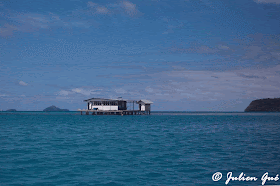Polynesian
lagoons' Black gold
Polynesians have discovered the pearl oyster before
the arrival of Europeans. They used the shell to make weapons and ornaments.
The Chinese are the ones who
invented the cultured pearl by introducing in the mantle of the oyster a lead
figurine with Buddha's effigy, around which the pearl had to settle.
But the real invention of
the process amounts undoubtedly to three Japanese who discovered in 1904, and
simultaneously, without knowing each other, the secret of the graft.
 |
| A pearl farm in the lagoon of Mangareva at the Gambier Islands |
In 1960, a certain Jean-Marie Domard matters
to Polynesia, the techniques used in Japan. In 1962, he managed to make the
"nucleate" of more than five thousand oysters. Three years later, he
got more than a thousand high quality pearls.
Mythology
The Polynesian mythology
talks about the black pearls as light caskets. They were given by the Creator
to Tāne, a divinity of Harmony and Beauty. He made out of them the stars which
he sent to Rua Hatu, God of the ocean for him to lighten his domain.
Then the god 'Oro, tutelary
divinity of war and peace, offered them to the women whom he coveted. At the
completion of his work, he gave the pearl oyster, "Te ufi", to the
humans in memory of his passage. Since then, "Te ufi" thrives in
Polynesian lagoons.
This treasure, a secret of
coral islands, has long been considered a royal symbol.
Birth of a pearl
A natural pearl is born when
a grain of sand comes into the shell of the oyster. Then the mother-of-pearl
will cover with successive layers of nacre until the intruder is completely
covered, what will take years.
 |
| Oysters awaiting the transplant |
Today, all the
"real" pearls, sold worldwide, are cultured pearls. Pearl farming
requires the following three steps: collection of spat, transplant operations,
harvesting.
Spat collection
The oyster spat is the raw material of
pearl-farming. The “collectors” (plastic bands) are suspended a few feet below
the surface of the lagoon. They are between 12 and 24 months under water to
produce juvenile 5 to 10 cm.
 |
| Precious pearls on a typical hanging net before being plunged back into the lagoon |
To achieve the graft size
between 9 and 11 cm, each shell is pierced at an "ear" and attached
to a 2 m cord, which constitute a string suspended as a pocket-net during 3 to
12 months.
The graft
Grafting consists in
inserting a nucleus into the "pearl pocket" of an oyster (it will
play the role of a grain of sand) and a graft (piece of organic tissue cut from
the mantle from a donor oyster).
 |
| The essential but very painstaking gesture of the graft |
The shell is slightly open to let the
transplant tools through. Once inserted into the oyster, the graft fuses with
living tissues and a pearl sac develops around the nucleus: this is the
starting point for the future pearl.
The transplant operation is
a traumatic process. The oysters that survive and retain the nucleus are bred
on rosary chains. It takes approximately 18 months to form a layer of nacre
thick 0.8mm.
For every hundred oysters grafted, only
twenty-five to thirty oysters give marketable pearls.
The harvest
Eighteen months after the transplant, it
is harvest without sacrificing the oyster. If the pearl is of exceptional
quality, a second grafting is performed with a nucleus of the size of the
harvested pearl. Oysters can be grafted two to three times.
The beauty of a pearl
depends on a large number of criteria: its shape, the state of its surface, its
color, its orient, its luster, its glow. Several faults can occur: hooping, pitting,
comets, blisters, no luster and pigmentation.
The Tahitian cultured pearl
is known in particular for the variety of its nuances of color
 |
| A nucleus and a beautiful Tahitian black pearl |
To ensure a quality recognized to the
black pearl of Tahiti, classification rules were defined:
• the diameter: it varies
from 8 to 18 mm and the nacre layer deposited around the cores should not be
less than 0.8 mm;
• the average weight: It
must be close to 1.6 g;
• the form: the pearls are
classified into round, semi-round, semi-baroque, baroque, and circled;
• quality: it depends on the
surface finish and gloss.
According to figures
published by the department of pearl farming, for twenty-five marketable pearls,
only five will be considered perfect.
The pearl and the economy
Pearl farming was, until
there is little, one of the main resources of French Polynesia. It employed
about seven thousand people divided, essentially, between the islands of the
Tuamotu, Society and Gambier Islands.
Having started with less than two pounds in 1978, in
2005, production of beads reached five tons. Most of this production is
exported to Asia and the United States after the Polynesian auctions in
Polynesia and Hong Kong.
 |
| The iridescent magic of the Tahitian black pearls |
While Polynesia remains one
of the world's leading exporters of black pearls, she must now face competition
from other countries in Oceania, particularly the Cook Islands, Fiji, Marshall
and Solomon. But above all to the total and chronic lack of a coherent trade
policy, the result of a very particular political situation
.
See also:
An article
of Julien Gué
Translated from French by Monak
Copyright
Julien Gué. Ask for the author’s agreement before any reproduction of the
text or the images on Internet or traditional press.
Aucun commentaire:
Enregistrer un commentaire
Cet article vous a fait réagir ? Partagez vos réactions ici :